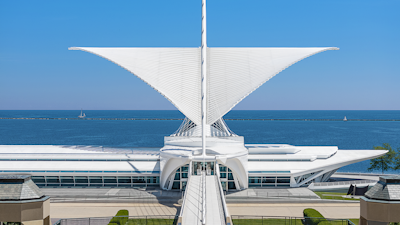Quadracci Pavilion


Overview
The Quadracci Pavilion is the iconic sculptural addition to the Milwaukee Art Museum designed by Santiago Calatrava. The Spanish architect was inspired by the “dramatic, original building by Eero Saarinen…the topography of the city” and Frank Lloyd Wright’s Prairie-style architecture.
The 142,050-square-foot structure was completed in 2001 and houses a grand reception hall, an auditorium, a large exhibition space, a store, a café, and parking. Both cutting-edge technology and old-world craftsmanship went into creating the graceful building, which was made largely by pouring concrete into one-of-a-kind wooden forms. In 2023, the Museum increased the Quadracci Pavilion’s lighting capabilities, allowing it to participate in citywide lighting events on a grander scale with arrays of colors.
Windhover Hall is the grand reception hall and among the pavilion’s many architectural highlights. Complete with flying buttresses, pointed arches, ribbed vaults, and a central nave topped by a 90-foot-high glass roof, it is Calatrava’s interpretation of a Gothic cathedral. An average-sized, two-story family home would fit comfortably inside it. The hall’s chancel is shaped like the prow of a ship, with floor-to-ceiling windows looking over Lake Michigan. Adjoining the central hall are two tow-arched promenades, the Baumgartner Galleria and Schroeder Galleria, with expansive views of the lake and downtown.
The Museum’s signature wings, the Burke Brise Soleil, form a moveable sunscreen with a 217-foot wingspan. The brise soleil is made up of 72 steel fins, ranging in length from 26 to 105 feet. The entire structure weighs 90 tons. It takes 3.5 minutes for the wings to open or close. Sensors on the fins continually monitor wind speed and direction, so when winds exceed 23 mph for more than 3 seconds, the wings close automatically.
According to Santiago Calatrava, the Quadracci Pavilion’s design “responds to the culture of the lake: the sailboats, the weather, the sense of motion and change.” And “in the crowning element of the brise soleil,” he stated, “the building’s form is at once formal (completing the composition), functional (controlling the level of light), symbolic (opening to welcome visitors), and iconic (creating a memorable image for the Museum and the city).”
The expansion of the Museum was made possible through the generosity of donors in a capital campaign, with major funding provided by Betty and Harry Quadracci.
Santiago Calatrava
Architect and sculptor Santiago Calatrava was born in Valencia, Spain, in 1951. He earned a degree in architecture and then in civil engineering, intrigued by the mathematics behind historic architecture. Early in his career, Calatrava worked as an engineer and began to enter architectural competitions, believing this was his most likely way to secure commissions. His first winning competition proposal, in 1983, was for the design and construction of Stadelhofen Railway Station in Zurich. The next year, Calatrava designed and built a bridge for the Olympic Games in Barcelona; this was the beginning of a series of bridge projects that established his international reputation.
In the mid-1980s, Calatrava began to get hired for large-scale public projects, and opened offices for his company in Zurich, Paris. and Valencia. During this period, he also began to exhibit his abstract sculptures in museums and galleries. Calatrava regularly traverses the lines between art and architecture; his buildings are frequently called sculptural, while his sculptures and paintings are like sketches of buildings.
Calatrava is known for his flowing, curved buildings. He uses steel, concrete, and new computer modeling to create compositions that appear at once natural and structurally impossible. If “form follows function” was a rallying cry of modern architecture, Calatrava’s postmodern structures turn this maxim on its head. His designs suggest stylized natural objects—waves, wings, or sun-bleached skeletons, with rows of white concrete ribs curved into distorted parabolic arches. The true purpose of these dramatic contours are typically more aesthetic than structural.
The Milwaukee Art Museum addition was Calatrava’s first project in the United States. Feeling insecure about working in the U.S., he actually withdrew himself from the selection process in 1994, only to be coaxed back. Today, Calatrava has completed dozens of buildings and bridges around the world, with many more in the works. His theatrical, uplifting designs are immediately recognizable, and often his buildings, like the Quadracci Pavilion, look poised to soar away on the breeze.
Calatrava on the Milwaukee Art Museum
After completing the Quadracci Pavilion, Santiago Calatrava discussed how he designed the addition and sought to integrate the Museum into the urban and natural landscapes around it. The excerpts below are from his speech at the Quadracci Pavilion dedication in October 2001.
“For me, the project of expanding the Milwaukee Art Museum was an opportunity to help people make the most of an extraordinary situation.
The design did not result from a sketch. It came out of a close collaboration with the clients…who truly wanted from me the best architecture that I could do. Their ambition was to create something exceptional for their community.
Rather than just add something to the existing buildings, I also wanted to add something to the lakefront. I have therefore worked to infuse the building with a certain sensitivity to the culture of the lake–the boats, the sails, and the always-changing landscape.
The extension, as such, is a kind of pavilion, transparent and light, which contrasts with the massive, compact Saarinen building. Reaching out from the Quadracci Pavilion, like an arm extended to the city, is a bridge.
Besides being a link to the city, the bridge is part of a composition. Its leaning mast conveys a sense of direction, of movement, which is taken up by the roof, the cables, and the canopies that extend on each side. These strong lines culminate in the Burke Brise Soleil, which translates their dynamism into actual motion.
I hope that…we have designed not a building, but a piece of the city.”
